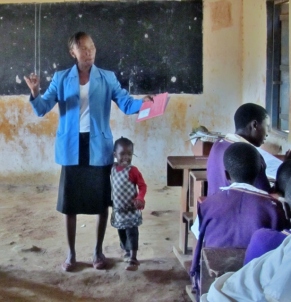Now the exciting teacher observations! Hildegard (Hilda) will soon be a master teacher. She is young, though she has 3 children 3, 5, and 7. In all the classes I have observed she has tried to apply upper level thinking questions. I n one English class she asked me to demonstrate so she could get a better idea of what we were talking about. So with 5 minutes warning, I did my best. What fun I had! Hilda translated for me so the students could better understand. Then she just took off! Another exciting lesson was on how to use a TV. First she had the students in groups brainstorming what was needed to operate a TV. After sharing their ideas we walked over to another teacher’s house nearby that had a TV. It started with the plug, socket and switch (power here is 220 volts and the plugs have switches), next pushing the on button on the TV, and then using the remote to change channels (though there was only one with programming.) In the class of 60 <10% of students have a TV and about 25% have electricity in their
n one English class she asked me to demonstrate so she could get a better idea of what we were talking about. So with 5 minutes warning, I did my best. What fun I had! Hilda translated for me so the students could better understand. Then she just took off! Another exciting lesson was on how to use a TV. First she had the students in groups brainstorming what was needed to operate a TV. After sharing their ideas we walked over to another teacher’s house nearby that had a TV. It started with the plug, socket and switch (power here is 220 volts and the plugs have switches), next pushing the on button on the TV, and then using the remote to change channels (though there was only one with programming.) In the class of 60 <10% of students have a TV and about 25% have electricity in their  houses. First, she demo-ed then had different students do the various steps needed. Finally a couple of students went through the entire process. During the lesson she had her 3 year old with here as her house-girl had not shown up. Next lesson is making circuits with batteries, bulbs and wire.
houses. First, she demo-ed then had different students do the various steps needed. Finally a couple of students went through the entire process. During the lesson she had her 3 year old with here as her house-girl had not shown up. Next lesson is making circuits with batteries, bulbs and wire.
Dickson missed the preparation workshops so he had a crash course in thinking level questioning. He struggled to understand and had difficulty doing a couple of the exercises we prepared that the others tried at the workshop. These were also activities we suggest the teachers try in the classroom. Dickson was starting a unit on tourism in Tanzania. We consulted before the class and I helped him choose the activity and questions. He chose to use a picture to elicit what students knew about tourism in Tanzania. His upbeat, animated manner in the classroom is awesome. He broke the students into groups each with a different question to answer that had several parts to the answer. A different child had to write each part. Then the groups reported out. When I asked Dickson after the class how he thought it went well, he was enthusiastic. He said the students were involved, interested and all working. Then with great surprise he said “I didn’t know they already knew so much about tourism!” Check out this You Tube video of Dickson. The photos I have of him are blurry he moves around so much. http://youtu.be/bhFh6BCLAzA
I hope after we do the group work workshop the groups will have more assigned roles but I have noticed that trying to do that now doesn’t work. However, whoever is writing gets help from the others and I have noticed that when the recorder changes all the students are involved. Usually one person does all the writing and maybe 2 others are involved and at least three are looking around. The writer is usually the same person every time. The students break into groups all the time because there are not enough text books to go around. Sometimes there has to be 8-10 students in a group with most of them trying to read sideways or upside down. As you can imagine only about 3 students are actually involved in the work.
